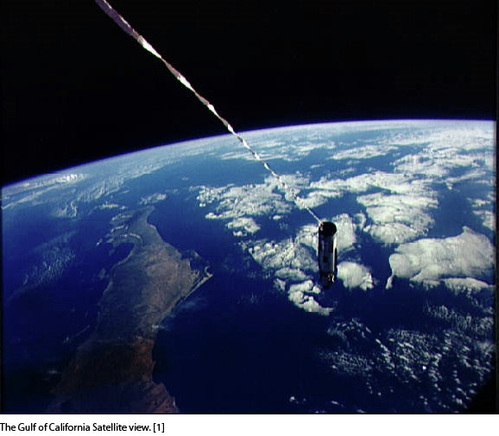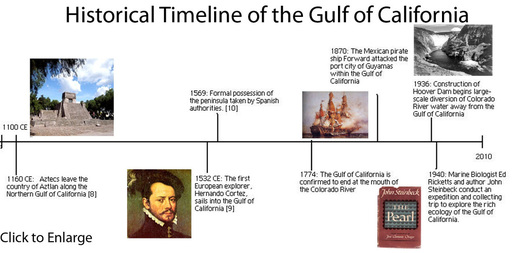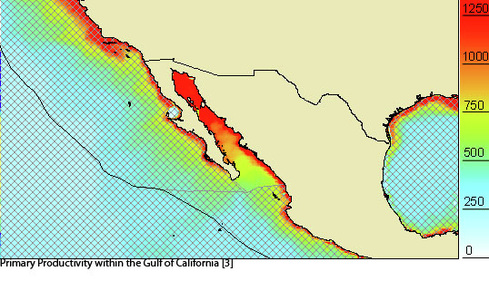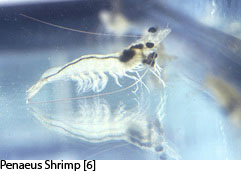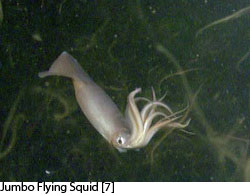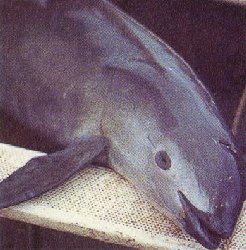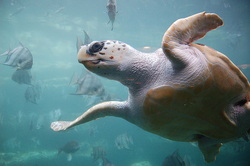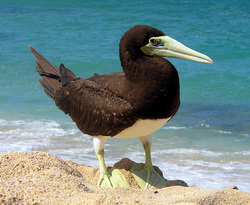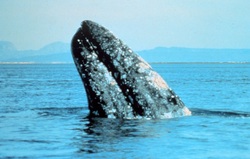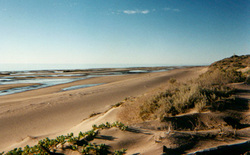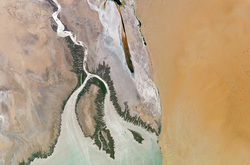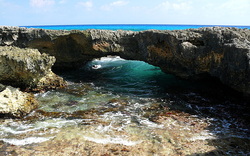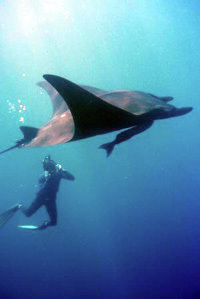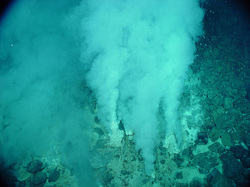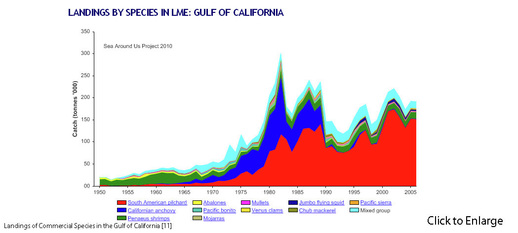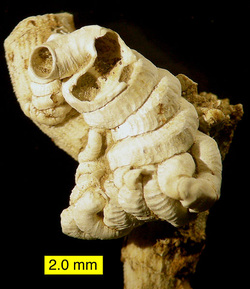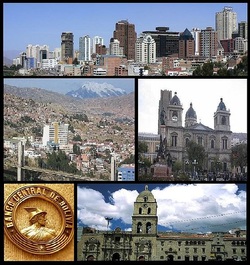The Gulf of California (Sea of Cortez)
Introduction
The Gulf of California, also referred to as the Sea of Cortez is located between the Mexican mainland and the Baja California peninsula. Recognized as a UNESCO World Heritage Site, the Gulf of California contains an incredibly diverse ecosystem that supports numerous species and provides multiple valuable ecosystem services including tourism and fishing.
A
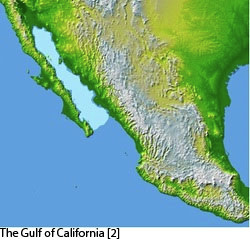
Length: 1126 km
Width: 48-241 km
Surface Area: 177,000 km^2
Mean Depth: 2684` m
Volume: 145,000km^3
Water Temperature: 16 C-24 C
Salinity: 35-35.8
Location: 24N and 32N latitude
Width: 48-241 km
Surface Area: 177,000 km^2
Mean Depth: 2684` m
Volume: 145,000km^3
Water Temperature: 16 C-24 C
Salinity: 35-35.8
Location: 24N and 32N latitude
Topography and Oceanography
A
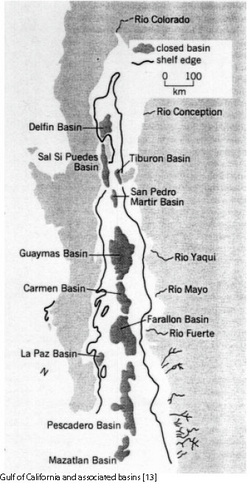
The Gulf of California was formed through a complex fault system along the Pacific Plate. Due to its location along a fault line, there are numerous volcanic islands present throughout the gulf as well as many deep sea hydrothermal vents. The Colorado River delta is located at the Northern head of the gulf, although it has been diverted in multiple areas further upstream and so its flow into the gulf has been greatly diminished. The bottom contains a number of basins which get progressively deeper as one progresses further South along the gulf.
Due to the funnel shape of the Gulf of California, tidal fluctuations range from 7 meters at the head of the Gulf of California to 1 meter at the mouth of the gulf. Large phytoplankton blooms are present which have given the nickname 'the Vermillion Sea' to the Gulf of California. Oceanographic currents are driven largely by wind which blows from the Northwest in the winter, pushing out the warmer surface waters and replacing them with cold nutrient rich waters from the Pacific. In the Summer, wind from the South pushes surface water into the gulf which forces deeper water out.
Back to top
Due to the funnel shape of the Gulf of California, tidal fluctuations range from 7 meters at the head of the Gulf of California to 1 meter at the mouth of the gulf. Large phytoplankton blooms are present which have given the nickname 'the Vermillion Sea' to the Gulf of California. Oceanographic currents are driven largely by wind which blows from the Northwest in the winter, pushing out the warmer surface waters and replacing them with cold nutrient rich waters from the Pacific. In the Summer, wind from the South pushes surface water into the gulf which forces deeper water out.
Back to top
History
Before the discovery of the Gulf of California by Hernan Cortez in 1532 CE it was inhabited by numerous Central American tribes which utilized the Gulf as a source of food, and as a source for shells and pearls which they traded [8,9]. After the discovery of the Gulf by Hernan Cortez, it was possessed by Spanish authorities and quickly colonized[10]. At first, the peninsula was determined to be an island and numerous expeditions were sent to the mouth of the Colorado to attempt a traverse around the island. During its early discovery and colonization, pirates and explorers were common along the coast which provide numerous anecdotal accounts of the abundance and biodiversity within the waters before major commercial fishing depleted resources [14].
Once the colonization of the Gulf began, commercial fisheries were established that targeted a multitude of marine fish, invertebrates, reptiles, and mammals. Additionally, a large pearling industry was established and romanticized in later generations [14]. One of the legends regarding an enormous pearl that brought tragedy to a small fishing village was the impetus behind John Steinbeck's novel The Pearl. The construction of the Hoover Dam as well as other dams along the Colorado River diverted water flow away from the Colorado River Delta in the mid-1900's drastically changing the habitat structure. The wild pearling industry as well as other fisheries such as the totoaba fishery collapsed in the later 1900's and the Mexican government began more carefully regulating the resources within the Gulf of California.
Back to top
Once the colonization of the Gulf began, commercial fisheries were established that targeted a multitude of marine fish, invertebrates, reptiles, and mammals. Additionally, a large pearling industry was established and romanticized in later generations [14]. One of the legends regarding an enormous pearl that brought tragedy to a small fishing village was the impetus behind John Steinbeck's novel The Pearl. The construction of the Hoover Dam as well as other dams along the Colorado River diverted water flow away from the Colorado River Delta in the mid-1900's drastically changing the habitat structure. The wild pearling industry as well as other fisheries such as the totoaba fishery collapsed in the later 1900's and the Mexican government began more carefully regulating the resources within the Gulf of California.
Back to top
Primary Production
Primary productivity within the Gulf of California is relatively high with an average of 1190 mgC·m-2·day-1[4]. The prominent primary producers of the Gulf of California are diatoms and dinoflagellates which occasionally bloom in enough abundance to give the sea the nickname the Vermilion Sea [5] for its red coloration. This high level of primary production is supported by upwelling from the Pacific Ocean during the winter and from large sediment influxes from the multitude of rivers that flow into the gulf.
Back to top
Back to top
Biodiversity and Food Web
Biodiversity-Invertebrates
The Gulf of California contains over 5000 macroinvertebrates, all of which are documented in the Gulf of California invertebrate database [16] multiple species are important as a food source for both fish and humans. The predominant invertebrate fishery within the Gulf of California relies on the Penaeus Shrimp there were also fisheries for abalone and pearl oysters in the past.
Biodiversity-Fishes
The gulf of California harbors a rich variety of fish species occupying multiple trophic levels ranging from the South American Pilchard to multiple gamefish such as billfish and tuna. Additionally there are many indigenous species of fish found only in the gulf of California such as the totoaba.
Biodiversity-Marine Mammals, Reptiles, and Birds
The Gulf of California contains the Vaquita porpoise, the smallest of all marine mammals and the rarest. With a population numbering in the hundreds, commercial fishing nets still present a huge threat to their population. Additionally grey whales migrate to the rich waters in the winter to breed and numerous other species of whale frequent the gulf. Five species of sea turtle frequent the waters of the gulf as well although their numbers have been greatly reduced. The islands within the gulf also present a habitat for many migratory seabirds to nest on and the estuaries provide a resting point for other seabirds as well.
Habitats
ROCKY AND SANDY SHORELINE
The coast along the gulf is renowned for its desert and coastline mixture which contains both rocky intertidal and sandy bottomed habitats. These habitats are home to a myriad of intertidal creatures which were the primary focus of John Steinbecks journey to the Gulf of California.
ESTUARIES
The Gulf of California is heavily Estuarine with multiple rivers flowing into its waters. Notably the Colorado River which forms the Colorado River Delta. Unfortunately recent urbanization and water relocation has drastically reduced estuarine habitats within the Gulf of California that serve as nurseries for juvenile fish and habitat for many important species.
PELAGIC ZONES
Offshore pelagic zones within the Gulf of California provide habitat for many marine mammals including the vaquita porpoise. Additionally they support a rich pelagic fishery which makes the gulf a popular tourist destination for sportfishing and ecotourism.
Habitat Changes
A
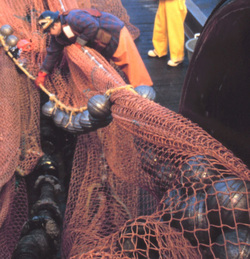
[33] Trawl net
Habitat destruction is an increasingly pressing issue within the Gulf of California. The most prominent concern is the effects that the decreased water flow from the Colorado River Delta due to damning and irrigation is causing. Because of the damming of the river, it is estimated that only 5% of the historical estuarine wetlands within that region are currently present [32].
Additionally, pollution and urbanization are causing numerous changes along the coastline, eutrophication from runoff is affecting nearshore marine habitats while urbanization driven by tourism is spurring development of the coast, destroying intertidal habitat and reef systems.
Commercial fishing is causing the most marine habitat destruction, due to poor commercial regulations, the sea floor is subjected to many bottom trawling devices which destroy habitat and result in high levels of bycatch. Additionally, other fisheries that utilize nets such as the penaeid shrimp fishery have large levels of bycatch on endangered species such as the vaquita porpoise and totoaba which alters habitat dynamics.
Back to Top
Additionally, pollution and urbanization are causing numerous changes along the coastline, eutrophication from runoff is affecting nearshore marine habitats while urbanization driven by tourism is spurring development of the coast, destroying intertidal habitat and reef systems.
Commercial fishing is causing the most marine habitat destruction, due to poor commercial regulations, the sea floor is subjected to many bottom trawling devices which destroy habitat and result in high levels of bycatch. Additionally, other fisheries that utilize nets such as the penaeid shrimp fishery have large levels of bycatch on endangered species such as the vaquita porpoise and totoaba which alters habitat dynamics.
Back to Top
Fisheries
Penaeid Shrimp
The Peneaid shrimp is the most economically important fishery within the Gulf of California. More than one quarter of Mexico's shrimp comes from the Gulf of California however, the main exporter is the United States. The fishery produces a large amount of bycatch unfortunately, with approximately 10 pounds of other organisms dying per pound of shrimp caught. [34]
Humboldt Squid
Recent climate changes and reduction in predators have allowed the Humboldt squid to increase its range into the Gulf of California. Their presence has allowed for a new fishery to form within the gulf for the squid.
Reduction Fishery
The largest catch per ton industry within the Gulf of California is the South Amercican pilchard which is used primarily in the reduction fishery. The South American Pilchard populations also work in equilibrium with the Northern Anchovy population, decreasing when the anchovy population is high and increasing when the anchovy population is low. Recent studies have shown a decrease in the South American pilchard populations and is attributed to either a resurgance of the Northern anchovy population or a possible collapse within the South American pilchard fishery. [35]
Sportfishing
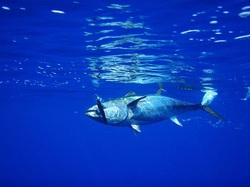
[38] Tuna fishing
A large sport fishing industry, centered around the booming tourism industry has recently been established. Fishing charters target a wide array of pelagic species including billfishes, tuna, wahoo, and dorado as well as many inshore species such as grouper and roosterfish. The industry is poorly observed and therefore information regarding its impact upon the fisheries is sparse..
Fisheries Management
Fisheries within the Gulf of California are managed by the Mexican Federal government however commercial managment is sparse and relatively lenient. Bycatch remains a huge problem, especially within the shrimp industry which allows for a large amount of discard, including the endangered vaquita porpoise and the totoaba. There are certain seasonal regulations as well as net size restrictions however catch shares are not implemented and few marine reserves are present with the largest one located at the mouth of the Colorado River Delta in order to protect the totoaba and vaquita porpoise and is considered a biosphere preserve [39].
The recreational fishery is also relatively light on management with an overall limit of 10 fish for any species and only 5 fish of one species may be take. The totoaba is the only protected fish within the regulations.
Back to Top
The recreational fishery is also relatively light on management with an overall limit of 10 fish for any species and only 5 fish of one species may be take. The totoaba is the only protected fish within the regulations.
Back to Top
Introduced Species
As a center of fishing and shipping since the 14 th century, the Gulf of California has had numerous contacts with species from around the world, while none of these species have caused a significant threat when compared with other problems within the gulf, they are present. Cryptic invasive species are the most problematic as the gulf has been utilized for centuries making many species that have been present for decades or even centuries possibly invasive. The humboldt squid discussed above has recently invaded the waters and even established itself as a fishery. Additionally, invasive tube-dwelling polychaetes are proving problematic as they are acting as boat fouling agents within the gulf and have established themselves from their native caribean waters, especially within the Southern Gulf [40].
Pollution
Pollution from increased urbanization and agricultural runoff is prominent within the Gulf of California, particularly within the Northern Gulf where evaporation concentrates chemical runoff and the Colorado River Delta dumps agricultural runoff into the Gulf. The Colorado River Delta is diverted along its route in many places for agricultural purposes, when it finally enters the Gulf of California it carries many pesticides and other pollutants with it [42]. Urbanization along the coast from tourism is also introducing many sources of pollution from both point and nonpoint source runoff and shipping within the gulf also presents a source of pollution including heavy metals and oil.
Regional Issues
Colorado River Delta
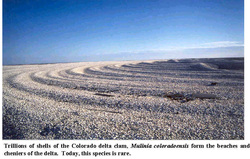
[45] Colorado Delta Clam shells
The diversion of the Colorado River Delta has had a major impact within the Gulf of California, particularly within the Northern Gulf of California where the river enters. The Colorado River flows through the US before entering Mexico where it is dammed for hydroelectric power and diverted for water to sustain the US states under the Colorado River compact. As the Colorado River enters Mexico, what remains of the water flow is further diverted into agricultural fields and for drinking. When it enters the Gulf of California, the flow is greatly diminished and the river is saturated with pesticides and pollutants from the agricultural fields. According to some estimates, the Colorado River has diminished in flow volume due to damming and irrigation from 18 billion m^3 of sediment to 8 billion m^3 of water. Additionally, it is estimated that nutrient rich sediment flowing from the Colorado River has been reduced from 160 billion kg of sediment to 12 billion kg of sediment [5] which has likely reduced primary production within the Gulf of California.
This has greatly affected the wetlands area in the Northern Gulf of Mexico which served as a nursing ground for juveniles and a home for many important marine animals. The endangered totoaba utilizes the Colorado River Delta as a juvenile, however due to the loss of habitat its population is not able to recover to historic levels. The changes have also altered major trophic dynamics, notably the populations of the Colorado Delta clam Mulinia coloradoensis which has drastically declined due to the loss of habitat which has favored harder shelled clams such as many Venus clam species [44]. This change in habitat dynamics has drastically altered the marine food web in this area as the venus clams are much harder for crustaceans such as crabs to consume.
Back to Top
This has greatly affected the wetlands area in the Northern Gulf of Mexico which served as a nursing ground for juveniles and a home for many important marine animals. The endangered totoaba utilizes the Colorado River Delta as a juvenile, however due to the loss of habitat its population is not able to recover to historic levels. The changes have also altered major trophic dynamics, notably the populations of the Colorado Delta clam Mulinia coloradoensis which has drastically declined due to the loss of habitat which has favored harder shelled clams such as many Venus clam species [44]. This change in habitat dynamics has drastically altered the marine food web in this area as the venus clams are much harder for crustaceans such as crabs to consume.
Back to Top
Solutions
Solutions to solving the decreased flow rate within the Colorado River Delta are present however they remain difficult to administer due to the importance of the river as a water source for human and agricultural uses. Cooperation between the US and Mexican government regarding water allotment is the first step to beginning habitat restoration of the delta. Increasing flow is the simplest and most effective option, even allowing polluted water to flow into the delta as the contaminents within the water are less problematic than the lack of water flow [46]. A marine biosphere reserve has also been established within the Delta region to protect the totoaba and vaquita porpoise, however with the habitat already declining due to outside influences, a reserve has little effect on recovery. However the most important factor within the restoration effort remains the cooperation between the US and Mexican governments and their willingness to allot vital water to the wetlands habitat of the Colorado River Delta.
Back to Top
Back to Top
References
References
[4] http://www.seaaroundus.org/lme/4.aspx
[5] http://www.utdallas.edu/~rnix/MAT-SE_Units/gulf_cal.pdf
[8] Haines, Helen. History of New Mexico. New Mexico Historical Publishing Co. 1898.
[9] http://www.divediscover.whoi.edu/expedition1/guaymas.html
[10]Jenkins, John. Explorations and Adventures in and around the Pacific and Antarctic Oceans. Hurst and Co Publishers. 1931.
[14] Pinnegar, John and Engelhard, Gearg. (2008) The shifting baseline phenomenon: a global perspective. Reviews in fishery Biology and Fisheries. 18 (1).
[15] Capitalistic Development in the Lower California Pearl Industry by Sanford Mosk
[16] http://www.desertmuseum.org/center/seaofcortez/database.php
[32] A Delta Once More www.edf.org/documents/425_Delta.pdf
[34] Gillett, R (2008). Global study of shrimp fisheries. FAO Fisheries Technical Paper. No. 475
[35] The rise and fall of the Pacific sardine, Sardinops sagax, in the Gulf of California, Mexico
[39] http://www.cedointercultural.org/uppergulf.htm
[40] Tovar-Hernandez, M. Mendez, N. Villalobos, G (2009). Fouling polychaete worms from the Southern Gulf of California: Sabellidae and Serpulidae. Systematics and Biodiversity. 7(3).
[42] http://www.eoearth.org/article/Gulf_of_California_large_marine_ecosystem
[44] http://www.conservationmagazine.org/2008/07/dig-deeper/.
[46] http://www.jstor.org/stable/2387153
[4] http://www.seaaroundus.org/lme/4.aspx
[5] http://www.utdallas.edu/~rnix/MAT-SE_Units/gulf_cal.pdf
[8] Haines, Helen. History of New Mexico. New Mexico Historical Publishing Co. 1898.
[9] http://www.divediscover.whoi.edu/expedition1/guaymas.html
[10]Jenkins, John. Explorations and Adventures in and around the Pacific and Antarctic Oceans. Hurst and Co Publishers. 1931.
[14] Pinnegar, John and Engelhard, Gearg. (2008) The shifting baseline phenomenon: a global perspective. Reviews in fishery Biology and Fisheries. 18 (1).
[15] Capitalistic Development in the Lower California Pearl Industry by Sanford Mosk
[16] http://www.desertmuseum.org/center/seaofcortez/database.php
[32] A Delta Once More www.edf.org/documents/425_Delta.pdf
[34] Gillett, R (2008). Global study of shrimp fisheries. FAO Fisheries Technical Paper. No. 475
[35] The rise and fall of the Pacific sardine, Sardinops sagax, in the Gulf of California, Mexico
[39] http://www.cedointercultural.org/uppergulf.htm
[40] Tovar-Hernandez, M. Mendez, N. Villalobos, G (2009). Fouling polychaete worms from the Southern Gulf of California: Sabellidae and Serpulidae. Systematics and Biodiversity. 7(3).
[42] http://www.eoearth.org/article/Gulf_of_California_large_marine_ecosystem
[44] http://www.conservationmagazine.org/2008/07/dig-deeper/.
[46] http://www.jstor.org/stable/2387153
References (image)
[1] http://www.nasaimages.org
[2] http://en.wikipedia.org/wiki/File:Wpdms_nasa_topo_gulf_of_california.jpg
[3] http://www.seaaroundus.org/primaryproduction/LMEpp_monthlyimages.htm?CountryID=4&FAO=0&CountryName=Gulf%20of%20California
[6]http://en.wikipedia.org/wiki/File:Penaeus_vannamei_01.jpg
[7]http://en.wikipedia.org/wiki/File:Dosidicus_gigas.jpg
[13] Ocean World Encyclopedia
[17] http://commons.wikimedia.org/wiki/Category:Sardinops_sagax
[18] http://www.nmfs.noaa.gov/pr/species/fish/totoaba.htm
[19] http://commons.wikimedia.org/wiki/File:Roosterfish.jpg
[20] http://commons.wikimedia.org/wiki/File:Tuna.jpg
[21] http://upload.wikimedia.org/wikipedia/commons/c/c2/Dolphinfish_(_Coryphaena_hippurus_).jpg
[22]http://commons.wikimedia.org/wiki/File:Marlin.png
[23] http://en.wikipedia.org/wiki/File:Gray_whale.jpg
[24] http://en.wikipedia.org/wiki/File:Vaquita.jpg
[25] http://en.wikipedia.org/wiki/File:Brown_booby.jpg
[26] http://en.wikipedia.org/wiki/File:Loggerhead_sea_turtle.jpg
[27]http://www.sonorandesertconservation.org/laestrella-ld.html
[28] http://visibleearth.nasa.gov/view_rec.php?id=16861
[29] http://commons.wikimedia.org/wiki/File:Cozumel_Windward_Reef-27527.jpg
[30] http://en.wikipedia.org/wiki/File:Giant_pacific_manta.jpg
[31] http://en.wikipedia.org/wiki/File:Champagne_vent_white_smokers.jpg
[33] http://en.wikipedia.org/wiki/File:Netbobbins.jpg
[36] http://en.wikipedia.org/wiki/File:Pacific_sardine002.jpg
[37] http://en.wikipedia.org/wiki/File:Anchovy_closeup.jpg
[38] http://commons.wikimedia.org/wiki/File:Thon.jpg
[41] http://en.wikipedia.org/wiki/File:SerpulidCyprusPliocene01.jpg
[43] http://en.wikipedia.org/wiki/File:La_Paz_Skyline_By_Dortega.jpg
[45] http://www.geo.arizona.edu/ceam/Hecold/wpe9.jpg
[1] http://www.nasaimages.org
[2] http://en.wikipedia.org/wiki/File:Wpdms_nasa_topo_gulf_of_california.jpg
[3] http://www.seaaroundus.org/primaryproduction/LMEpp_monthlyimages.htm?CountryID=4&FAO=0&CountryName=Gulf%20of%20California
[6]http://en.wikipedia.org/wiki/File:Penaeus_vannamei_01.jpg
[7]http://en.wikipedia.org/wiki/File:Dosidicus_gigas.jpg
[13] Ocean World Encyclopedia
[17] http://commons.wikimedia.org/wiki/Category:Sardinops_sagax
[18] http://www.nmfs.noaa.gov/pr/species/fish/totoaba.htm
[19] http://commons.wikimedia.org/wiki/File:Roosterfish.jpg
[20] http://commons.wikimedia.org/wiki/File:Tuna.jpg
[21] http://upload.wikimedia.org/wikipedia/commons/c/c2/Dolphinfish_(_Coryphaena_hippurus_).jpg
[22]http://commons.wikimedia.org/wiki/File:Marlin.png
[23] http://en.wikipedia.org/wiki/File:Gray_whale.jpg
[24] http://en.wikipedia.org/wiki/File:Vaquita.jpg
[25] http://en.wikipedia.org/wiki/File:Brown_booby.jpg
[26] http://en.wikipedia.org/wiki/File:Loggerhead_sea_turtle.jpg
[27]http://www.sonorandesertconservation.org/laestrella-ld.html
[28] http://visibleearth.nasa.gov/view_rec.php?id=16861
[29] http://commons.wikimedia.org/wiki/File:Cozumel_Windward_Reef-27527.jpg
[30] http://en.wikipedia.org/wiki/File:Giant_pacific_manta.jpg
[31] http://en.wikipedia.org/wiki/File:Champagne_vent_white_smokers.jpg
[33] http://en.wikipedia.org/wiki/File:Netbobbins.jpg
[36] http://en.wikipedia.org/wiki/File:Pacific_sardine002.jpg
[37] http://en.wikipedia.org/wiki/File:Anchovy_closeup.jpg
[38] http://commons.wikimedia.org/wiki/File:Thon.jpg
[41] http://en.wikipedia.org/wiki/File:SerpulidCyprusPliocene01.jpg
[43] http://en.wikipedia.org/wiki/File:La_Paz_Skyline_By_Dortega.jpg
[45] http://www.geo.arizona.edu/ceam/Hecold/wpe9.jpg
